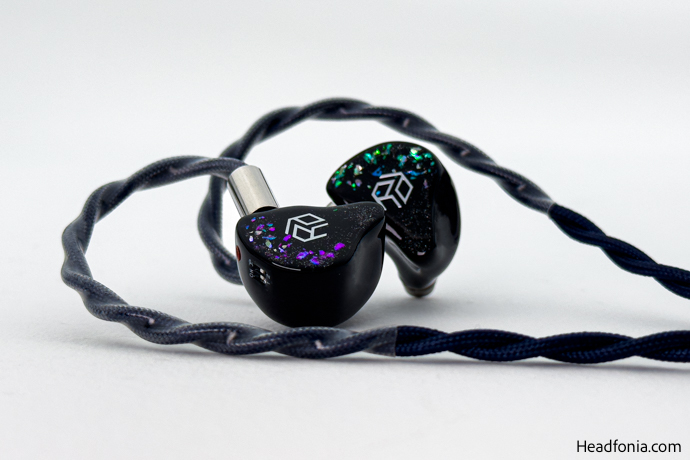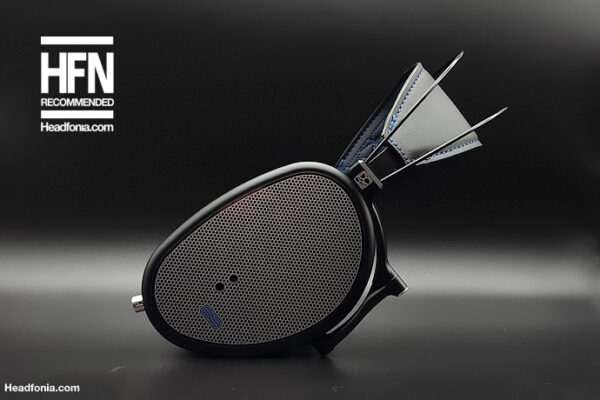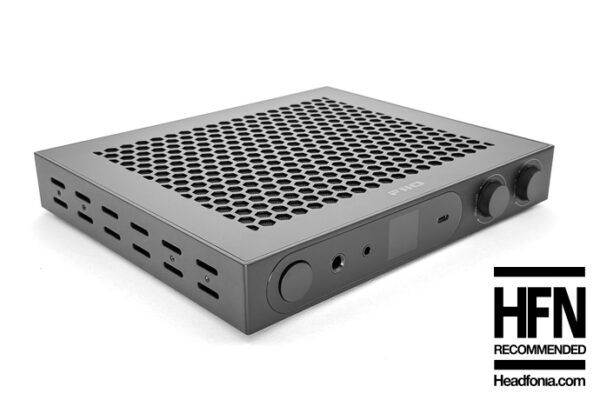Yanyin Moonlight Ultra – Sound
Similar to the non-ultra Moonlight that we reviewed a while back, the Moonlight Ultra sounds detailed and dynamic with plenty of headroom. It is fairly balanced with an emphasis on the bass. The bass is tastefully boosted, and not overdone. The bass elevation increases the perception of dynamism and articulacy, resulting in an engaging overall signature.
Like its predecessor, the Ultra is technically capable tribrid. I have listened to it extensively, using Topping’s G5 and Chord’s Mojo 2 as two main sources.

Low
The Yanyin Moonlight Ultra is a unique beast in the bass department. It is equipped with a new and revised 10mm custom dynamic driver and it is capable of deep, impactful lows. The new driver is striking an ideal equilibrium between power and speed, delivering a surprisingly fast bass for the quantity. The bass of the Moonlight Ultra is highly scalable – pair it with a high-quality DAC & AMP, and you will experience a reproduction that preserves its clarity and power across a variety of music genres.
Mid
The Moonlight Ultra’s midrange is characterized by balance and neutrality. It showcases a crystal-clear, balanced reproduction throughout the entire midrange. Vocals feel just right, not overly forward nor recessed, and carry a good amount of detail. The instruments are presented with precision, with a subtle enhancement to their note weight/body originating from the bass region.
The mids have a good sense of space and air, due to the transparent upper midrange. The upper mids don’t overstep – they’re beautifully tuned, delivering detail and extension without unwanted shrillness. Overall, the upper midrange is tuned in a way that is detailed but smooth, worthy of a flagship IEM.
High
Doubling the EST driver count from its predecessor, the Moonlight Ultra enhances resolution and transparency without increasing quantity. Providing rich detail, resolution, and a well-tuned presence, the treble stays dynamic and engaging without becoming strident or excessively bright. The extension is impressive and so is the resolution. The ESTs are conservatively tuned, they are not overly bright or forward, and they follow the guidelines of Ultra’s signature, being smooth and detailed.

Customizability
There are two tuning switches on the back of the Moonlight Ultra that allow you to manipulate certain frequency ranges. Yanyin’s intention with these switches is to give users a degree of customization, but in my tests, I found the effect of the switches to be quite minimal.
From my findings, activating the switches results in a slight decrease in bass and upper midrange quantity, but the alterations in other areas are virtually undetectable. Moreover, even the modifications in bass and upper-mid frequencies are extremely subtle and hard to discern. After spending several hours experimenting, I chose to proceed with writing this review with both switches deactivated.
Technical Capability
The technical prowess of the Moonlight Ultra is impressive, to say the least. Showcasing excellent control across the frequency range and a balanced signature with a neutral tonality, except for the emphasized bass, it effortlessly handles complex passages, accurately positioning instruments and vocals layer by layer. The Moonlight Ultra offers enhanced imaging compared to its predecessor, adding to what we already liked about the Moonlight. The headroom is wide and spacious, with good depth. Its solid PRaT ensures that the signature is engaging and dynamic, no matter the genre.
Comparisons
Yanyin Moonlight ($649 USD)
We have mentioned the non-ultra Moonlight many times in the article, but in this paragraph, I have focused on summarising the differences between the two products. I have again used the G5 and Mojo 2 as sources. Let’s take a closer look at the Moon brothers.
In terms of design, the Moonlight is smaller and has a thinner body compared to the Ultra. Both have similar shell and nozzle designs using identical resin and custom faceplates. Both feel comfortable in my ears with their anatomically optimized shells.

Sound-wise, the Moonlight sounds slightly more linear with slightly less bass quantity. The texture is similar but Ultra feels a tad more tight and punchy. Their midranges are similar, both have good, smooth, and detailed mids with good note weight. One exception is that the Moonlight’s reproduction of woodwind instruments is slightly lighter in tonality compared to the Ultra. As for the treble, the Ultra has a couple more ESTs compared to its predecessor and showcases more extension to the top octave.
It is slightly more energetic and resolving compared to the non-ultra Moonlight. The extra ESTs provide a good boost to the resolution of the treble, improving the transparency of the upper mid and treble regions. The Ultra feels like a Moonlight on steroids to my ears, improving upon what’s already great about the OG Moonlight.
That being said, the OG Moonlight is still an excellent choice if the Moonlight Ultra is out of your budget.
ThieAudio Prestige ($1299 USD)
Both monitors are flagship products from their respective manufacturers and are indeed solid IEMs. I have evaluated both, using the Mojo 2 and G5 as sources, and will share my findings in this paragraph.
First and foremost, both models feature an impressive and comfortable fit in my ears, causing no discomfort even after hours of continuous use. The design and build quality of both are excellent, in line with their pricing.
While the sound quality of both is quite good, subtle differences are noticeable. The Moonlight Ultra has a slightly tighter and deeper bass reproduction compared to the Prestige. The Prestige, however, showcases superior speed and agility in the sub-bass department, particularly noticeable on tracks featuring twin pedal passages. Although the Moonlight Ultra feels somewhat lighter in the mid-bass region, both models deliver an expansive and airy overall midrange. The Prestige’s attack and decay are somewhat more pronounced and energetic, while the Moonlight Ultra leans more toward gentler notes, being smoother.
In general, this specific observation of mine applies to the whole sound signature as the Moonlight Ultra is smoother across the ranges, with less micro-detail and more musicality. While both models offer a comparable resolution, I found the Prestige to be more resolving, mainly due to its slightly more forward/open tonality. Both products use EST drivers in the high frequencies and both manage to convey a good amount of detail without being bright. In conclusion, I can wholeheartedly recommend both models.

Last Words
All things considered, the Yanyin Moonlight Ultra stands tall in the thousand-dollar arena. Offering a smooth and detailed experience from deep, textured bass to neutral midrange and expansive, transparent treble, it’s a beautifully engineered unit that invites the listener to go back for more, track after track. If you’re in the market for a smooth flagship IEM that pairs harmoniously with a wide range of genres, the Moonlight Ultra certainly deserves a listen. Rest assured, Yanyin won’t leave you yearning for more.
Pros
+ Great SQ
+ Great technical foundation
+ Smooth and detailed signature
Cons
– Switches are not very useful
– Limited ear tip options
– Stiff cable
Page 1: Yanyin, Moonlight Ultra, Packaging & Accessories, Design, Build & Fit
Page 2: Sound, Low, Mid, High, Technical Capability, Comparison, Last Words







